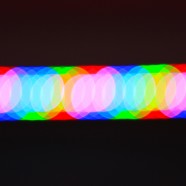What Is Li Fi Technology? LED Lights Connecting Us To The Internet
Li fi technology, also known as light fidelity or Visible Light Communication (VLC), uses flickering LED lights to transfer wireless data.
If you’re reading this, chances are you’re familiar with Wi-fi and have probably already used it at some point today. Wi-fi is a technology that allows you to use radio waves to connect to the internet. But what if instead of spewing out Wi-fi radio waves throughout your house and apartment, you used highly directed beams of LED light?
A Li-fi connection would allow your laptop, smartphone or tablet to connect to the internet via the same lights used to light your room. The LED networks work by flickering light at a rapid fire rate, invisible to the human eye. To connect to a Li-fi network, devices must be equipped with the capability to recognize the LED light signals and use them to transfer data.
The term “Li-fi” was coined by Harald Haas at a 2011 TED talk, during which he explained that by using a flickering LED light outfitted with a microchip, data can be transferred to laptops and mobile devices. The advantages of Li-fi over Wi-fi are numerous; they increase network security, don’t emit radiation and speed up connection rates.
A multitude of micro-LED bulbs allows streams of light to be beamed in parallel, with each stream multiplying how much data can be carried over the connection. Each bulb is enabled to handle millions of changes in light intensity per second, acting as an extremely fast on and off switch and allowing a high speed transfer of binary data – a series of ones and zeros.
“If you think of a shower head separating water out into parallel streams, that’s how we can make light behave,” Professor Harald Haas told the BBC.
VICE News reports that LED light networks are already being installed in museums and businesses across France. Furthermore, France’s leading utility company EDF has embraced the concept.
According to Cedric Mayer, who works for a company that has been building a Li-fi transmitter, the French government is receptive to the idea because lighting is inexpensive, more secure, and doesn’t transmit radiation.
LED-internet transmitters also allow data signals to be displayed on phones and devices simply by placing the device under the flickering LED lamp. This could be used to display information such as train or bus schedules. Advertisers could also use the lamps to spread advertising messages.
Mexican company Sisoft claims it has used Li-fi to transfer audio, video and internet at rates of up to 10 gigabits per second, which is already faster than many Wi-fi connections.
The bandwidth of visible light, which is part of the electromagnetic spectrum, is 10,000 times larger than the radio frequency spectrum used by Wi-fi, theoretically allowing for a vastly greater carrying capacity.
Li-fi promises to be cheaper and more energy efficient than existing Wi-fi technology due to the widespread acceptance of LED lighting technology in consumer and commercial markets worldwide.
LED lights and Li-fi technology are quickly incorporating themselves into the rapidly expanding field of the Internet of Things (IoT), ushering in a new era of household-internet connectivity.











